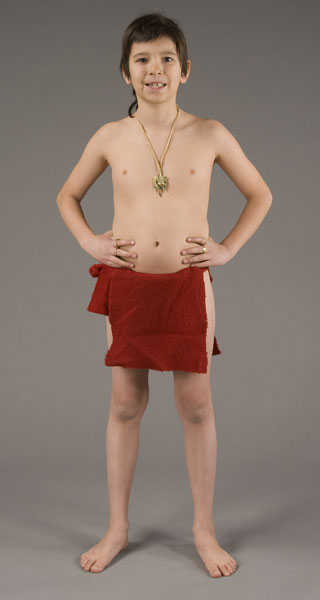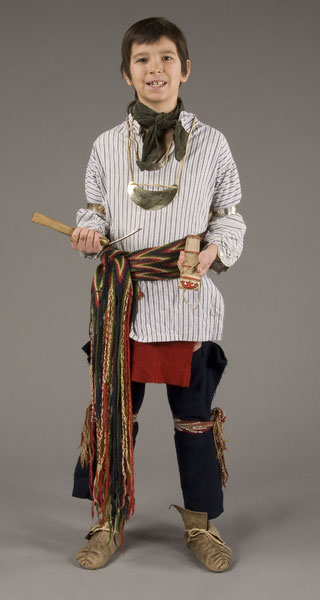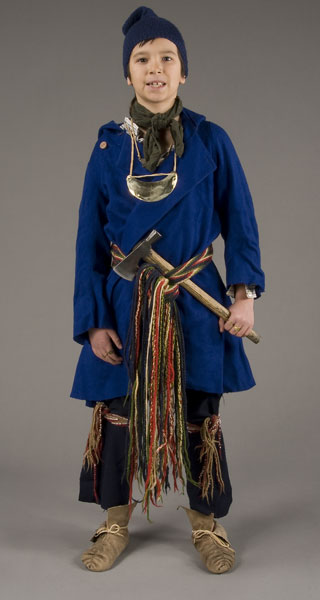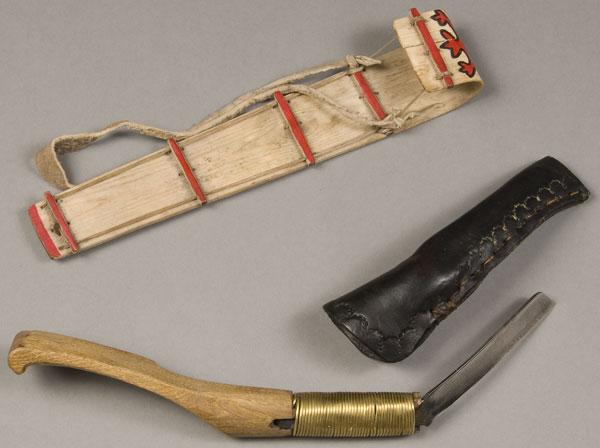




Advanced Search
Dress Up | 1st Person | African American Map | Now Read This | Magic Lens | In the Round | Tool Videos | Architecture | e-Postcards | Chronologies Turns Activities
Wôbanaki Boy's Clothing from 1800By 1800, quite a few Wôbanaki people were living in a manner very similar to those Americans and Canadians of European descent. They often wore the same styles of clothes, lived in the same kinds of houses and had many of the same types of possessions. Many Native people, however, kept some elements of tradition, by wearing moccasins and leggings, decorating their clothing with silver ornaments, or keeping their hair long. Some chose to keep traditional ways of life and to acquire just a few European items, like the boy described here, who wears a few items of clothing from the French Canadian people. As a very young boy or girl, a Wôbanaki child might wear only a breechclout or nothing at all in the warm weather. Otherwise, children would dress like their parents. Wôbanaki people slept in what was most suited to the season. In the winter this would mean wearing several layers to bed; in hot weather a child might sleep without clothing. Among the numerous items for trade in the 1800s were wool, linen, silk, and cotton cloth, ready-made shirts and coats, knitted wool hats and mittens, felted wool top hats, glass beads, silver jewelry, and metal axe heads and knife blades. Native American people in New England would trade with European people in either Canada or the United States. Items they received might come from England, France, Holland, or as far away as India and China. Go to interactive Flash version
Breechclout or BreechclothA breechclout, called “adhozoan”, is a strip of fabric or deerskin that goes between the legs and is held in place by a belt tied around the waist. The breechclout might be compared to modern-day shorts, underwear, or bathing suit. This boy's breechclout is made of wool.
ShirtThis boy's shirt is made of cotton. In Abenaki, a shirt is called “wihibaks”. It is the same style that European boys would wear, but theirs would be tucked into their trousers. GorgetsWhen worn by a British or French military officer, a "gorget" was a badge of office, signifying that the man was not a common soldier. Wôbanaki people liked to wear gorgets simply for adornment. People cut up brass kettles received in trade to make their own gorgets. This boy wears a large gorget, or "arenarakk8i-psk8s8ann" made from a brass kettle and a smaller gorget of silver. ArmbandsThese are silver armbands, called “wpedinibial”, worn for decoration. KerchiefThis is a silk kerchief. The silk would have been imported from India. The Abenaki borrowed the English word for silk, calling it “silki”. MoccasinsThese are summer-weight moccasins with a center seam. They are made from the hide of a white-tailed deer. The Abenaki word for all kinds of shoes is "mkezenal". The English adapted this word into “moccasin”. LeggingsThese are wool leggings, called “medasal”. They are tied to a belt at the waist to keep them up. Leggings were worn for warmth and to protect one's legs when walking through scratchy undergrowth. It is interesting to note that wool cloth used for clothing by Native people at this time was usually either red or blue.
|
| |
Home | Online Collection | Things
To Do | Turns
Exhibit | Classroom | Chronologies My
Collection
About This Site | Site Index | Site Search | Feedback


 Sash & Garters
Sash & Garters
